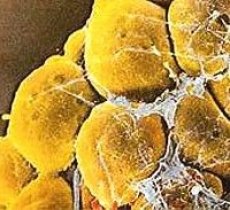A new type of adipose tissue is described
Last reviewed: 23.04.2024

All iLive content is medically reviewed or fact checked to ensure as much factual accuracy as possible.
We have strict sourcing guidelines and only link to reputable media sites, academic research institutions and, whenever possible, medically peer reviewed studies. Note that the numbers in parentheses ([1], [2], etc.) are clickable links to these studies.
If you feel that any of our content is inaccurate, out-of-date, or otherwise questionable, please select it and press Ctrl + Enter.

A new type of fat tissue is described - beige fat. Its cells are similar to brown fat cells and also burn excess lipids with the formation of heat, but differ in a set of essential biochemical and genetic traits.
Two types of adipose tissue are known - white and brown. White fat accumulates lipids, brown - burns and at the same time produces heat. Not so long ago it was believed that brown fat is only found in animals and infants, but adults do not. Then it was found in adults, and in this connection the idea arose that brown fat can be used as a remedy for obesity: the fat burning brown cells could reduce fat deposits in white cells.
Researchers from the Dana-Farber Cancer Institute (USA) added a third to these two fats, called "beige" (or "light brown"). For the first time scientists came across this type of adipose tissue in 2008. In their new article in Cell magazine, they just explain that beige fat is quite an independent species, not a kind of brown, but like brown fat, it burns lipid stocks accumulating in white adipocytes. In adults, beige fat forms small subcutaneous clumps near the clavicles and along the spine.

Generally speaking, researchers believe that the brown fat that was discovered in adults is not really brown, but beige. Although it is easy to confuse them, there are very significant differences between these two types of fat cells. Brown cells maintain a constant high level of protein UCP1: it is necessary that mitochondria effectively process fat with the release of heat. In beige cells, the level of this protein is low, although they also contain many mitochondria. But under the influence of some factors - for example, in response to cold - the synthesis of UCP1 in beige fat can increase. In addition, beige cells can be stimulated with hormone irisin (which not so long ago appeared in the news, true, due to brown fat).
Brown and beige fats differ in origin. Brown cells appear from stem progenitors common to them and to muscle cells. Beige has its own progenitor cells, and they are formed in clusters of white fat. Beige fat can burn lipids with almost the same efficiency as brown. So, if adult brown fat is really not real, researchers just need to forget about it and do beige, which can also be used to regulate metabolism and prevent obesity.
However, it is possible that somewhere near the person hides and real brown fat: it is very difficult to imagine that scientists for so long did not pay attention to its differences from vsamdelishnogo, animal brown fat.

 [
[